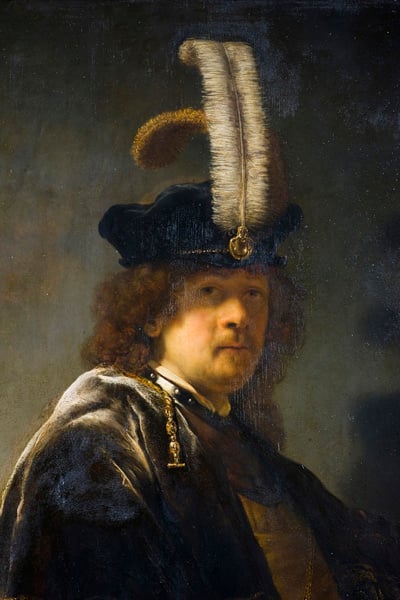Analysis
$50 Million Rembrandt Selfie Authenticated
Eight months of research has proven it's the real deal.

Eight months of research has proven it's the real deal.

Alexander Forbes


Detail of recently authenticated Rembrandt self-portrait (1635)
Photo: National Trust
Britain’s National Trust has snagged their first Rembrandt. Well, to be fair, they have owned the painting for nearly four years. But, thought to be a fake or a copy, the work was left in storage at Devon’s Buckland Abbey, the former home of Sir Francis Drake.
Now, after eight months of testing, restoration, and analysis, researchers have determined that the self-portrait from 1635 is indeed the work of the Dutch master. Rembrandt’s first-ever ‘selfie,’ which depicts the artist at the age of 29, the work is estimated to be worth in the realm of £30 million ($50 million). Though, the National Trust says they’ll never sell.
Donated to the trust from the estate of Edna, Lady Samuel of Wych Cross in September 2010, the painting has been the subject of a rowdy authentication debate for nearly 50 years. Lady Samuel’s husband purchased the painting in the 1960s. In 1968, Horst Gerson, a noted Rembrandt specialist and the Rembrandt Research Project expressed their collective doubts regarding the self-portrait’s authenticity. They thought that it was the work of one of Rembrandt’s students, if it had any connection to the painter at all.
That judgment stuck until 2005 when a subsequent Rembrandt expert, Ernst van de Wetering began to take interest in the work and question whether his colleagues had got it wrong. He went to see it in person in 2013 after which, he told the Independent, “I was pretty certain the painting was a Rembrandt.” But more tests and empirical data were needed to properly authenticate the work. So, it was sent to the renowned Hamilton Kerr Institute (HKI) in Cambridgeshire.
The HKI’s Chrstine Slottvedd Kimbriel told the AFP, “Careful cleaning and removal of several layers of aged and yellowed varnish which had been added to the painting much later, revealed the original colours and painting style beneath.” She said this allowed for much more detail to emerge, particularly in Rembrandt’s execution of the fabrics depicted in the portrait. A previously-perceived lack of detail due to the varnish had led experts to doubt the painting’s authenticity.
“It’s now much easier to appreciate it as a Rembrandt.”
Paintings and sculpture curator at the National Trust, David Taylor echoed the importance Slottvedd Kimbriel placed on restoration efforts in the ability for the work to be authenticated. “The key element for me has been the cleaning,” he told the AFP. “The varnish was so yellow that it was difficult to see how beautifully the portrait had been painted. Now you can really see all the flesh tones and other colours, as well as the way in which the paint has been handled – it’s now much easier to appreciate it as a Rembrandt.”
Close attention was also paid to the artist’s signature. Experts in the past had cited that while the painting was dated 1635, the style in which Rembrandt signed the painting looked much more like one he used later in his career. However, “cross-section analysis left no reason to doubt that the inscription was added at the time of execution of the painting,” Slottvedd Kimbriel said.
In celebration of the find Buckland Abbey is opening a special exhibition of the piece, titled Rembrandt Revealed, which opens on June 13.